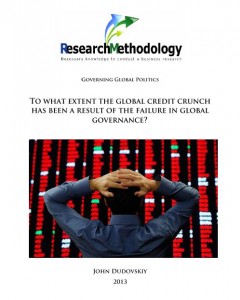To What Extent the Global Credit Crunch has been a Result of the Failure in Global Governance?

- Published: December 2013
- 3945 Words
- 17 Pages
This paper critically analyses the extent at which a failure in global governance contributed to the recent global credit crunch. The paper starts with discussing the primary reasons of the credit crunch of 2007-2009, and its implications on the global economy. This is followed by analysis of the current state of global governance, and its impact on credit crunch. Moreover, the paper highlights potentials for avoiding credit crunch in the future through improving global governance practices.
The global economic and financial crisis of 2007 – 2009 has shed a light in inefficiencies of the international financial system and the current pattern of the global governance. The current system of global financial governance has found to be mainly insufficient to predict and contains financial instability. The need for efficient global governance needs a shift to an improved balance between the two worlds of financial globalization i.e. private financial activity and public financial governance (Porter, 2009).
The credit crunch reveals great challenges and threats to the developed economies as well as developing states. The global banking industry, which was by far the most profitable sector in 2006, is in much trouble and the risk that this poses to the real economy is thoughtful (Wade, 2008).
The global financial crisis of 2007-triggered by the sub-prime mortgage crisis in the spring previously led to a significant decrease in production in autumn 2008, which has continued in 2009 and went on to produce the spring of 2009 to the present day effects, both social (rising unemployment decrease in disposable income, declining demand, social problems) and political (government changes, erosion of confidence citizens in the performance of governments and the political class), and thus increased the difficulties of public finances in developed countries causing in 2010 a series of crises (Nesvetailova, 2010).
1. Introduction 1
2. Credit Crunch of 2007 – 2009: Reasons and Implications 2
3. The Current State of Global Governance and Its Impact on Credit Crunch 6
4. Potentials for Avoiding Credit Crunch in the Future through Improving Global Governance Practices 12
5. Conclusions 15
References 17
List of Figures
Figure 1 Fixed interest rate trend history for the past 30 years 4
Figure 2 Dependency of IMF to lend finances 7
Figure 3 Requirements for global governance 8
Figure 4 Advantages and disadvantages of government networks 13
ECB
European Bank for Reconstruction and Development
Lehman Brothers
- Published: December 2013
- 3945 Words
- 17 Pages




